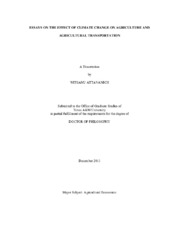| dc.contributor.advisor | McCarl, Bruce A. | |
| dc.creator | Attavanich, Witsanu | |
| dc.date.accessioned | 2012-02-14T22:20:14Z | |
| dc.date.accessioned | 2012-02-16T16:15:15Z | |
| dc.date.available | 2014-01-15T07:05:27Z | |
| dc.date.created | 2011-12 | |
| dc.date.issued | 2012-02-14 | |
| dc.date.submitted | December 2011 | |
| dc.identifier.uri | https://hdl.handle.net/1969.1/ETD-TAMU-2011-12-10493 | |
| dc.description.abstract | This dissertation analyzes the impact of climate, and atmospheric carbon dioxide (CO2) on crop yields and grain transportation. The analysis of crop yields endeavors to advance the literature by statistically estimating the effects of atmospheric carbon dioxide (CO2) on observed crop yields. This is done using an econometric model estimated over pooled historical data for 1950-2009 and data from the free air CO2 enrichment experiments. The main findings are: 1) yields of soybeans, cotton, and wheat directly respond to the elevated CO2, while yields of corn and sorghum do not; 2) the effect of crop technological progress on mean yields is non-linear; 3) ignoring atmospheric CO2 in an econometric model of crop yield likely leads to overestimates of the pure effects of climate change and technological progress on crop yields; and 4) average climate conditions and climate variability contribute in a statistically significant way to average crop yields and their variability.
To examine climate change impacts on grain transportation flows, this study employs two modeling systems, a U.S. agricultural sector model and an international grain transportation model, with linked inputs/outputs. The main findings are that under climate change: 1) the excess supply of corn and soybeans generally increases in Northern U.S. regions, while it declines in Central and Southern regions; 2) the Corn Belt, the largest producer of corn in the U.S., is anticipated to ship less corn; 3) the importance of lower Mississippi River ports, the largest current destination for U.S. grain exports, diminishes under the climate change cases, whereas the role of Pacific Northwest ports, Great Lakes ports, and Atlantic ports is projected to increase; 4) the demand for grain shipment via rail and truck rises, while demand for barge transport drops. | en |
| dc.format.mimetype | application/pdf | |
| dc.language.iso | en_US | |
| dc.subject | Agricultural Transportation | en |
| dc.subject | Climate Change and Agriculture | en |
| dc.subject | Production Economics | en |
| dc.subject | Climate Change and Crop Yield | en |
| dc.subject | Climate Change and Yield Variability | en |
| dc.subject | Carbon Dioxide Fertilization and Crop Yield | en |
| dc.subject | Climate Change and Transportation | en |
| dc.subject | Transportation Economics | en |
| dc.subject | Effect of Climate Change on Agriculture | en |
| dc.subject | Grain Transportation | en |
| dc.subject | Extreme Events and Crop Yield | en |
| dc.subject | Climate Change and Welfare | en |
| dc.subject | Climate Change and Market | en |
| dc.subject | Technological Change and Crop Yield | en |
| dc.subject | Free Air Carbon Dioxide Enrichment Experiments | en |
| dc.title | Essays on the Effect of Climate Change on Agriculture and Agricultural Transportation | en |
| dc.type | Thesis | en |
| thesis.degree.department | Agricultural Economics | en |
| thesis.degree.discipline | Agricultural Economics | en |
| thesis.degree.grantor | Texas A&M University | en |
| thesis.degree.name | Doctor of Philosophy | en |
| thesis.degree.level | Doctoral | en |
| dc.contributor.committeeMember | Wu, Ximing | |
| dc.contributor.committeeMember | Woodward, Richard T. | |
| dc.contributor.committeeMember | Vedenov, Dmitry V. | |
| dc.contributor.committeeMember | Puller, Steven | |
| dc.type.genre | thesis | en |
| dc.type.material | text | en |
| local.embargo.terms | 2014-01-15 | |


